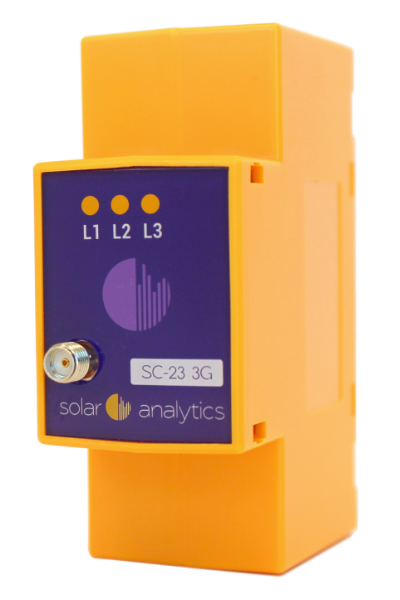Study shows half of 8,000 NSW solar systems are underperforming. Here's one solution.
Solar Analytics is installing its sophisticated solar performance monitoring software service to give maximum value to customers’ solar panel systems. It will measure the efficiency of solar panels and say what electricity is being used by each of the household appliances.
This can be bundled with Wattwatchers energy flow metering devices providing real-time data streams.
[For a detailed, technical and costs analysis of the off-grid battery and solar system on my house, Sydney's Sustainable House, see this blog.]
The combined Solar Analytics + Wattwatchers solution will be applied in two off-grid projects in Newtown, Sydney, one being researched by Street Coolers, the other being designed and coached by Michael Mobbs, the Off-grid Guy. The systems will monitor:
· The Athena Community School in Oxford Street, Newtown, NSW, as a retrofit to an existing 10kW rooftop solar PV system, measuring solar output, whole-of-school energy consumption, and main grid import/export.
· The Kylie House off-grid project, across the road from the school at No. 13, with installation into a new power board being fitted as part of the major sustainable renovation of the terrace home including the addition of a 3.5kW solar PV and battery storage.
This versatile monitoring solution operates independent of the utility-provided billing meter and puts the electricity user – in this case the school and the homeowner, Kylie Ahern – in control of their own energy data.
The school, Kylie and the system providers also will have online access to all of the data to support monitoring and verification of our activities and their outputs. This will support further project development at Newtown, knowledge sharing with other sites, and detailed reporting to participants and key stakeholder including the community, NSW Government and Marrickville Council.
Snapshot of how it works:
1. Wattwatchers’ compact energy metering sensors are hard-wired into the meter box by an electrician (like a circuit breaker).
2. Electrician places current transformer (CT) clamps over all circuits to be monitored, including solar output and, for so long as it’s connected, main grid connection.
3. Each household appliance will be monitored to match product specifications with actual power use, and to enable more efficient use of the appliances – for example, the washing machine may be used when the sun is strongest thereby keeping the batteries as fully charged as possible.
4. Once installed, devices are powered up and begin transmitting digital ‘packets’ of energy data - measured in 5-second blocks – via the mobile spectrum (3G SIM embedded in metering device).
5. Data goes to Solar Analytics cloud server and is analysed in its software system with other inputs including weather data and purpose-developed algorithms, providing detailed performance assessment and 24/7 trouble-shooting.
6. The Solar Analytics software monitors real-time solar energy system performance - energy consumption, solar production, faults, downtime, energy bought and sold. Consumers will receive any fault alerts and advice immediately by email (which often will be eligible for repair or replacement under warranty). They can also access their dashboard on the solar Analytics website online from any computer, tablet or smartphone to check energy usage and system performance, and receive monthly reports that provide valuable insight.
7. This provides constant assurance that the PV system is performing to expectations, saving the consumer money and reducing greenhouse gas emissions, and informs optimal on-site energy management and investment decision-making (e.g. energy-efficient major appliances, fit-outs such as LEDs, addition of battery storage or extra solar panels, going off-grid)
Solar Analytics co-founder and managing director Stefan Jarnason tells me that his Australian-owned company is committed to helping distributed solar PV generation become the world’s dominant energy source.
‘Intelligent solar monitoring is vital to achieving this outcome because it helps to improve the performance of every solar PV system. We’re delighted to team up with Wattwatchers to support the Newtown project participants by retrofitting the Athena school with monitoring and providing a new-install solution for the Kylie House.’
According to Wattwatchers director of community networks Murray Hogarth, the combination of the two Australian-developed technologies is providing an ‘Internet of Energy Things’ solution based on real-time energy data.
‘The Wattwatchers devices capture the data and communicate it to the Internet, then Solar Analytics aggregates it, analyses it and produces actions such as alerts and reports, with machine learning as more and more sites are monitored and more and more data circulates around the loop.’
Kylie will publish the data on this blog and on her blog.
A solution to a problem
Most of Australia’s existing 1.5 million rooftop solar photovoltaic (PV) systems have been installed without any remote monitoring of production and performance.
The majority of people rely on their monthly or quarterly utility bill and/or direct observation of their solar inverter to confirm that their solar system is operating and repaying their investment.
As a result, when systems fail the average time solar systems are offline is about four months, and chronic decline in performance caused by everything from shading to equipment flaws often goes completely unnoticed. It’s estimated by Solar Analytics that over 40% of systems already installed in Australia have low-quality panels, inverters and/or workmanship
A study by SunWiz of 8000 NSW solar systems showed that half of installed systems are underperforming. Increasingly, progressive solar installers and solar financiers are incorporating intelligent monitoring as a prerequisite, and it is expected that by 2020 all installations will have intelligent monitoring.
The impending rapid uptake of battery storage solutions will further drive the need for intelligent monitoring of solar and and all household energy flows.



